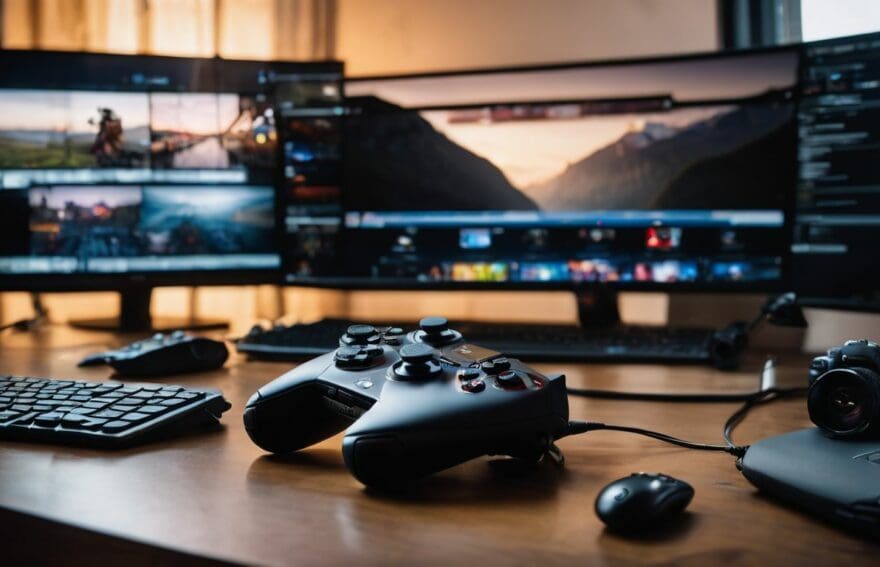Dynamic Difficulty Adjustment (DDA) in Esports Training

Updated On: February 28, 2024 by Aaron Connolly
If you’ve ever felt like you’re battling to keep your gaming prowess at its peak, fear not – it’s a common challenge among the brigade of digital adventurers. In our in-depth exploration, Dynamic Difficulty Adjustment (DDA) stands out as a beacon of hope for those keen on refining their esports skills.
Our forthcoming blog is brimming with insights on how to leverage DDA during training sessions, enhancing both your skill set and overall enjoyment of the game. With this savvy approach, that elusive winning edge might just be within reach.
Stay tuned for tips that could well put you on the podium!
Key Takeaways
- Dynamic Difficulty Adjustment, or DDA, enhances esports training by automatically adjusting game difficulty to match a player’s ability. This keeps players engaged and helps improve their skills without overwhelming them.
- Techniques like reinforcement learning, Monte Carlo tree search, and deep learning are used in DDA to create real-time challenges that adapt to individual player performance. These techniques help tailor the gaming experience for every level of player skill.
- While DDA has many benefits such as customising challenges and improving player satisfaction, it also faces criticisms including a potential over-reliance on algorithms which might lead to unbalanced gameplay if not carefully implemented.
- The future of DDA in esports looks promising with ongoing advancements in human – computer interaction offering even more personalised gaming experiences. As this technology continues to develop, it could become a core component of esports training programmes.
- It is important for those implementing DDA in esports training to balance algorithmic adjustments with human oversight to ensure fairness and maintain the integrity of competitive play.
Understanding Dynamic Difficulty Adjustment (DDA)
Dynamic Difficulty Adjustment (DDA) refers to the real-time modification of a game’s difficulty level based on the player’s skill level and performance. It aims to enhance the player experience by customising difficulty levels to match individual abilities.
Definition and purpose
Dynamic Difficulty Adjustment (DDA) is a method that transforms video games into highly adaptable arenas. This technology auto-tunes the game’s features and scenarios to match your skill level, creating a tailored gaming experience for every player.
It works like an automatic gear shift in a car – seamlessly adjusting to ensure you’re challenged just enough to stay engaged without feeling overwhelmed.
The purpose of DDA is straightforward: it aims to enhance your enjoyment and keep you playing longer. Whether you’re an esports professional training for the next big competition or someone who plays for fun, DDA adjusts the game’s difficulty on-the-fly.
By doing this, games become more accessible and enjoyable to a broader range of players, helping everyone from beginners to pros develop their skills at their own pace.
History of DDA in gaming
Over time, the concept of Dynamic Difficulty Adjustment (DDA) has evolved to become an integral part of gaming. It traces its roots back to the early days of video games when developers sought ways to enhance player engagement by tailoring the difficulty level to individual skill.
Through ongoing research and advancements in game artificial intelligence, DDA has transitioned from a novel idea to a sophisticated technology that significantly impacts player experience.
In the 1980s, early experiments with adaptive difficulty emerged as developers strived to fine-tune gameplay experiences. These efforts paved the way for today’s advanced algorithms and techniques used in dynamic game difficulty balancing.
The Impact of DDA in Esports Training
DDA in Esports Training has a significant impact on improving player performance, enhancing player satisfaction, and customising difficulty levels to suit individual skill levels and preferences.
These factors play a crucial role in shaping the overall esports training experience.
Improving player performance
Dynamic Difficulty Adjustment (DDA) in esports training has a significant impact on improving player performance. By tailoring the game’s difficulty level to match the player’s skill, DDA ensures that gamers are consistently challenged without being overwhelmed or bored.
This real-time modification of game scenarios through DDA contributes to skill development and enhanced performance, providing a more engaging and satisfying user experience for players.
Using techniques such as reinforcement learning and deep reinforcement learning, DDA optimises gameplay to help gamers refine their skills effectively. As algorithms adjust difficulty levels based on individual player competency, esports athletes can focus on honing their abilities within an environment that continuously adapts to their progress.
Enhancing player satisfaction
Dynamic Difficulty Adjustment (DDA) contributes to enhancing player satisfaction as it tailors the game difficulty to match the skill level of individual players. This means that gamers experience a more personalised and enjoyable gameplay, leading to increased engagement and overall satisfaction with their gaming experience.
DDA ensures that players do not face frustration due to an overly challenging game or become bored by an excessively easy one, thereby creating a more fulfilling and immersive gaming environment.
By providing adaptive difficulty levels based on each player’s skill, DDA optimises the challenge in games for continuous motivation and enjoyment. Tailoring the game experience in this way encourages novice gamers to improve while keeping experienced players engaged, promoting a sense of accomplishment and providing a more rewarding experience for all types of players.
Customising difficulty levels
Customising difficulty levels in esports training is a vital aspect that can greatly impact a player’s development. Tailoring difficulty levels according to individual skill sets can significantly enhance the learning process, providing challenges that are both engaging and beneficial. Here are some methods used to customise difficulty levels in esports training:
- Using reinforcement learning algorithms allows for adaptive difficulty adjustments based on a player’s performance, ensuring that the game consistently matches their skill level.
- Employing Monte-Carlo tree search techniques enables the game to dynamically modify its complexity in real-time, offering tailored challenges that suit the player’s abilities.
- Leveraging deep learning technology permits the game to analyse a player’s behaviour and responses, leading to the precise adjustment of difficulty levels for an optimal training experience.
- Implementing human – computer interaction advancements facilitates the customisation of gameplay features, mechanics, and scenarios to align with an individual’s skill progression accurately.
- Integrating DDA into esports training programmes offers players personalised difficulty levels, fostering continuous improvement and enhancing their competitive gaming prowess.
Techniques Used in DDA for Esports Training
Techniques such as reinforcement learning, Monte-Carlo tree search, and deep learning are employed to dynamically adjust the difficulty in esports training, allowing players to continuously improve their skills in a challenging yet rewarding environment.
These advanced techniques enable real-time modification of gameplay to tailor the experience based on individual player performance.
Reinforcement learning
Reinforcement learning is a key technique used in Dynamic Difficulty Adjustment (DDA) for esports training. It involves the game environment providing feedback to players based on their actions, encouraging them to make decisions that lead to a desired outcome.
Through reinforcement learning, games can adapt and customise difficulty levels in real-time, providing players with tailored challenges that match their skill level. This not only enhances player engagement but also promotes continuous skill development by dynamically adjusting the gameplay experience according to individual performance.
Reinforcement learning enables DDA systems to observe player behaviour and adjust the game’s difficulty accordingly without requiring pre-programmed rules or scenarios. By leveraging this technique, esports training programmes can offer personalised experiences that cater to each player’s abilities, fostering an environment where improvement is both challenging and rewarding.
Monte-Carlo tree search
Monte-Carlo tree search is a sophisticated algorithm used in Dynamic Difficulty Adjustment (DDA) for Esports Training. This technique allows the game to simulate various moves and outcomes, helping to determine the best course of action based on the current state of play.
By analysing potential moves and their consequences, Monte-Carlo tree search can dynamically adjust the difficulty level in real-time as per the player’s skills, providing a tailored gaming experience.
This method assists in improving player engagement and satisfaction by ensuring that the game adapts to individual skill levels. With Monte-Carlo tree search, esports training becomes more personalised and effective as it provides adaptive difficulty levels, enhancing players’ performance while maintaining an optimal level of challenge.
Deep learning
Continuing our exploration of techniques used in Dynamic Difficulty Adjustment (DDA) for esports training, we turn our attention to deep learning. This approach involves the use of neural networks to enable computers to learn from data and make decisions based on that learning.
Deep learning algorithms can analyse vast amounts of gaming data to identify patterns and adjust game difficulty in real-time, providing a personalised experience for each player.
Deep learning holds significant potential for enhancing esports training by enabling games to adapt dynamically to an individual player’s skill level and style. By leveraging this technology, game designers can create more engaging and challenging experiences that are tailored to the specific needs of players, ultimately improving their skills and enjoyment.
Challenges and Criticisms of DDA
Some challenges and criticisms of DDA in esports training include potential over-reliance on algorithms and the possibility of creating unbalanced gameplay. Interested in learning more about how DDA is shaping the future of esports training? Keep reading!
Over-reliance on algorithms
Over-reliance on algorithms can lead to a lack of human intuition in adjusting game difficulty. This can potentially limit the adaptability of Dynamic Difficulty Adjustment (DDA) systems, impacting the overall gaming experience.
When DDA relies too heavily on automated processes, it may not accurately capture the nuances and subtleties of player skill levels required for effective training and gameplay optimisation.
Algorithms should be used as tools to support DDA rather than as the sole determinant of difficulty adjustments. By incorporating human input and oversight, games can strike a balance between algorithmic precision and intuitive understanding, ensuring that player skills are accurately evaluated and challenged in esports training scenarios.
Potential for creating unbalanced gameplay
Implementing Dynamic Difficulty Adjustment (DDA) in esports training has the potential for creating unbalanced gameplay. This can occur when the DDA algorithms fail to accurately assess a player’s skill level, resulting in either overly challenging or excessively easy gameplay.
The use of DDA must be carefully monitored and refined to ensure that it enhances the training experience without creating unfair advantages or disadvantages for players.
Considering the potential for creating unbalanced gameplay is crucial when integrating DDA into esports training programs, as maintaining fair competition and challenge levels contributes significantly to the overall gaming experience.
The Future of DDA in Esports Training
Advancements in human-computer interaction and the potential for further development and integration into training programmes make the future of DDA in esports training an exciting prospect.
Interested to learn more about how DDA is shaping the world of competitive gaming? Keep reading!
Advancements in human-computer interaction
Recent advancements in human-computer interaction have revolutionised the way players engage with esports training programmes. Game optimisation through real-time modification of game mechanics and features has significantly enhanced the player experience.
With DDA technology, personalised difficulty levels are tailored to individual player skill, leading to improved performance and overall enjoyment. The integration of DDA into esports training holds promise for further development, offering an exciting future for adaptive and engaging training programmes.
Next up: “Potential for further development and integration into training programmes”
Potential for further development and integration into training programmes
Dynamic Difficulty Adjustment (DDA) holds immense potential for further development and integration into esports training programmes. By leveraging DDA, tailored difficulty levels can be provided to players, enhancing their skills and performance in a personalised manner.
This approach not only improves player engagement but also offers a dynamic training environment that adapts to individual skill levels, ultimately contributing to a more effective and rewarding training experience.
Research continues to explore the impact of DDA on player engagement and experience in games, shaping the future of esports training. The advancements in human-computer interaction provide opportunities for integrating DDA into training programmes at a deeper level, ensuring that players receive adaptive and personalised difficulty levels that optimise their skill development.
Conclusion
In conclusion, Dynamic Difficulty Adjustment (DDA) presents exciting opportunities for esports training. It offers a way to enhance player performance and satisfaction by customising difficulty levels in real-time.
The advancements in human-computer interaction and further development of DDA can revolutionise the training experience for esports players. Implementing DDA with care, considering challenges and criticisms, will be instrumental in shaping the future of esports training.
FAQs
1. What is Dynamic Difficulty Adjustment in esports training?
Dynamic Difficulty Adjustment, or DDA, is a method used in video game design to change the game’s difficulty in real-time based on how well the player is performing.
2. How does DDA enhance player enjoyment?
By automatically modifying the challenge level, DDA keeps players engaged and helps prevent frustration or boredom during esports training sessions.
3. Can DDA improve my skills in esports?
Yes, using DDA during your training can boost your performance by providing you with customised challenges that adapt to your skill level as you improve.
4. Is Dynamic Difficulty Adjustment included in all video games?
Not every game features Dynamic Difficulty Adjustment; however, it’s becoming more popular in video game design for its ability to cater to different player abilities and enhance overall enjoyment.


